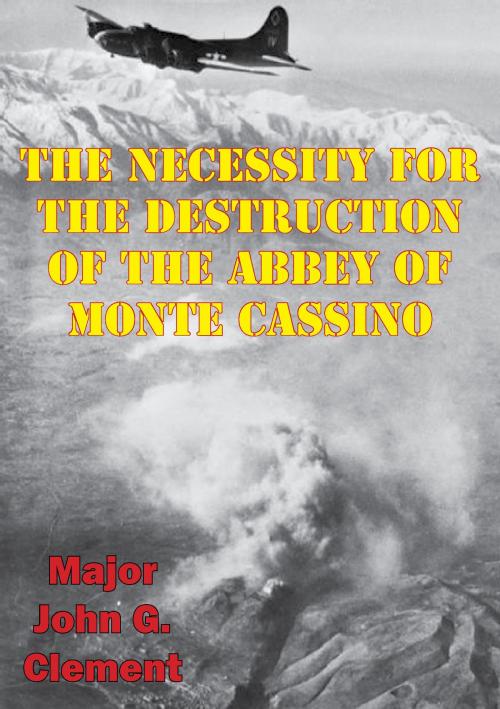The Necessity For The Destruction Of The Abbey Of Monte Cassino
Nonfiction, History, Germany, European General, Military, United States| Author: | Major John G. Clement | ISBN: | 9781786250353 |
| Publisher: | Lucknow Books | Publication: | November 6, 2015 |
| Imprint: | Lucknow Books | Language: | English |
| Author: | Major John G. Clement |
| ISBN: | 9781786250353 |
| Publisher: | Lucknow Books |
| Publication: | November 6, 2015 |
| Imprint: | Lucknow Books |
| Language: | English |
The Abbey of Monte Cassino, founded by Saint Benedict in A.D. 529, at the beginning of the Italian campaign was one of only two sites requiring special consideration in the interest of historical preservation. The monastery overlooked the only north-south road from Naples to Rome. The promontory, studied by the Italian War College as an example of a position made impregnable by nature, was the focal point of the German Gustav Line. The German defensive scheme did not include the monastery but did establish positions within 300 meters of its outer walls. After the lackluster landing at Anzio, the Fifth Army was obligated to conduct a winter campaign to break through the Gustav Line and relieve Anzio. In a sinister scape of bush and rock, soldiers endured immeasurable hardships while the monastery stood immune to the scars of war. On 15 February 1944, 253 tons of explosives were dropped on the Abbey of Monte Cassino as hundreds of refugees and wounded assembled in the chapel for morning services. The German paratroopers survived the onslaught of Allied airpower without a casualty and occupied the ruins that would serve as a strongpoint for the next four months. The perceived necessity for the bombing was nested in leadership interpretation of military necessity, psychological impact, and political considerations. Because the bombing was not coordinated with the ground assault, it was tactically irrelevant and failed to meet the requirements of military necessity. Decisions made to bolster friendly morale and to avoid political conflict are not intended for the defeat of the enemy and also fail to meet the requirements of necessity. The bombing was a careless act resulting in the needless death of civilians, destruction of a sacred building, and a waste of valuable military resources.
The Abbey of Monte Cassino, founded by Saint Benedict in A.D. 529, at the beginning of the Italian campaign was one of only two sites requiring special consideration in the interest of historical preservation. The monastery overlooked the only north-south road from Naples to Rome. The promontory, studied by the Italian War College as an example of a position made impregnable by nature, was the focal point of the German Gustav Line. The German defensive scheme did not include the monastery but did establish positions within 300 meters of its outer walls. After the lackluster landing at Anzio, the Fifth Army was obligated to conduct a winter campaign to break through the Gustav Line and relieve Anzio. In a sinister scape of bush and rock, soldiers endured immeasurable hardships while the monastery stood immune to the scars of war. On 15 February 1944, 253 tons of explosives were dropped on the Abbey of Monte Cassino as hundreds of refugees and wounded assembled in the chapel for morning services. The German paratroopers survived the onslaught of Allied airpower without a casualty and occupied the ruins that would serve as a strongpoint for the next four months. The perceived necessity for the bombing was nested in leadership interpretation of military necessity, psychological impact, and political considerations. Because the bombing was not coordinated with the ground assault, it was tactically irrelevant and failed to meet the requirements of military necessity. Decisions made to bolster friendly morale and to avoid political conflict are not intended for the defeat of the enemy and also fail to meet the requirements of necessity. The bombing was a careless act resulting in the needless death of civilians, destruction of a sacred building, and a waste of valuable military resources.





![Cover of the book A Soldier’s Manuscript [Illustrated Edition] by Major John G. Clement](https://www.kuoky.com/images/2014/august/300x300/9781782894810-I60d_300x.jpg)


![Cover of the book From Mons To Loos - The Diary Of A Supply Officer [Illustrated Edition] by Major John G. Clement](https://www.kuoky.com/images/2014/august/300x300/9781782894681-tsvI_300x.jpg)



![Cover of the book With The French Flying Corps [Illustrated Edition] by Major John G. Clement](https://www.kuoky.com/images/2013/january/300x300/9781782891208-VpwD_300x.jpg)


![Cover of the book Guymeyer — The Ace Of Aces. [Illustrated Edition] by Major John G. Clement](https://www.kuoky.com/images/2012/april/300x300/9781782890812-oKhD_300x.jpg)